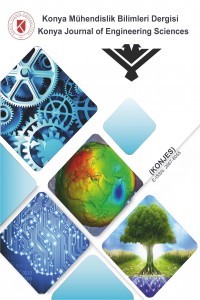BÜTÜNLEŞİK ÜRETİM VE DAĞITIM PROBLEMLERİ İÇİN YENİ BİR ÇÖZÜM YAKLAŞIMI: MATEMATİKSEL MODELLEME
Üretim ve dağıtım faaliyetleri tedarik zinciri yönetiminde çok temel iki unsurdur. Literatürde bu iki problem genellikle birbirinden bağımsız olarak ele alınmaktadır. Ancak daha düşük sistem maliyeti için bu iki fonksiyonun bütünleşik olarak değerlendirilmesi gerektiği açıktır. Dolayısıyla kurumsal işletmeler sürdürülebilir rekabet için üretim ve dağıtım kararlarını birlikte almalıdır. Bu gereklilik üzerine son yıllarda üretim ve dağıtım problemlerinin entegre olarak ele alındığı çalışmalar artmaya başlamıştır. Bu çalışmada ilk olarak üretim problemi özdeş olmayan paralel makineler ortamına indirgenmiş ve bir matematiksel model önerilmiştir. Daha sonra dağıtım kararlarının verilmesinde araç rotalama problemi üzerinde durulmuş ve bir diğer matematiksel model geliştirilmiştir. Son olarak bu iki model temel alınarak üretim ve dağıtım problemlerini eş zamanlı çözen yeni bir model önerilmiş ve modelin geçerliliği örnek problem vasıtasıyla sağlanmıştır.
Anahtar Kelimeler:
Çizelgeleme, Özdeş Olmayan Paralel Makineler, Araç Rotalama, Tedarik Zinciri
A New Solution Approach to the Integrated Production and Distribution Problem: A Mathematical Modeling
Production and distribution activities are two basic elements in supply chain management. In literature, these problems are generally considered separately. However, it is clear that both activities have to be handled simultaneously in order to provide less system cost. Hence, enterprises are made their decisions concurrently with regard to production and distribution decisions for sustainable competitiveness. Based on this necessity, production and distribution problems have recently started to be studied together. In this paper, we first deal with production problems, reducing it to the unrelated parallel machine environment and a mathematical model is proposed. Then, we put an emphasis on the vehicle routing problem which is a strong connection with distribution decisions and develop another model. Finally, a new mathematical model formulation solving two integrated problems is developed and an illustrative example is given to validate the mathematical model.
Keywords:
Scheduling, Unrelated Parallel Machines, Vehicle Routing, Supply Chain,
___
- Golden, B., Raghavan, S., Wasil, E., 2008, The Vehicle Routing Problem: Latest Advances and New Challenges, Volume 43, Springer, A.B.D.
- Chen, J.-F., 2005, “Unrelated Parallel Machine Scheduling with Secondary Resource Constraints”, The International Journal of Advanced Manufacturing Technology, Vol. 26, No. 3, pp. 285-292.
- Demircioğlu, M., 2009, “Araç rotalama probleminin sezgisel bir yaklaşım ile çözümlenmesi üzerine bir uygulama”, Doktora Tezi, Çukurova Üniversitesi, Sosyal Bilimler Enstitüsü, Adana.
- Düzakın, E., Demircioğlu, M., 2009, “Araç Rotalama Problemleri ve Çözüm Yöntemleri”, Çukurova Üniversitesi İİBF Dergisi, Vol. 13, No. 1, pp. 29-45.
- Erdinç, S.S., Ünlüakın, D.Ö., 2010, Bir Lojistik Şirketinin Araç Rotalama Problemi İçin Bir Matematiksel Model, http://people.sabanciuniv.edu/.../04-C6-.pptx, ziyaret tarihi: 14 Haziran 2012.
- Eryavuz, M., Gencer, C., 2001, “Araç rotalama problemine ait bir uygulama”, Süleyman Demirel Üniversitesi, iktisadi ve İdari Bilimler Fakültesi, Vol. 6, No. 1, pp. 139-155.
- Kara, İ., Derya, T., 2010, “Mesafe Kısıtlı Araç Rotalama Problemi İçin Doğrusal Programlama Tabanlı Sezgisel Bir Yöntem”, Yöneylem Araştırması / Endüstri Mühendisliği XXVI.Ulusal Kongresi, Başkent Üniversitesi Mühendislik Fakültesi Endüstri Mühendisliği Bölümü, Ankara, 3-5 Temmuz 2006.
- Laporte, G.,. 1992 “The vehicle routing problem: An overview of exact and approximate algorithms”, European Journal of Operational Research, Vol. 59, pp.345-358.
- Li, K., Yang, S.-L., 2009. “Non-identical Parallel-Machine Scheduling Research with Minimizing Total Weighted Completion Times: Models, Relaxations and Algorithms”, Applied Mathematical Modeling, Vol. 33, No. 4, pp. 2145-2158.
- Liaw, C.-F., Lin, Y.-K., Cheng, C.-Y., Chen, M., 2003, “Scheduling Unrelated Parallel Machines to Minimize Total Weighted Tardiness”, Computers and Operations Research, Vol. 30, No. 12, pp. 1777-1789.
- Martello, S., Soumis, F., Toth, P., 1996, “Exact and Approximation Algorithms for Makespan Minimization on Unrelated Parallel Machines”, Discrete Applied Mathematics, Vol. 75, pp. 169-188.
- Mokotoff, E., Chretienne, P., 2000, “A Cutting Plane Algorithm for the Unrelated Parallel Machine Scheduling Problem”, European Journal of Operational Research, Vol. 141, No. 3, pp. 515-525.
- Pinedo, M.L., 2008, “Scheduling Theory, Algorithms, and Systems”, Springer, New York, USA.
- Rocha, P.L., Ravetti, M.G., Mateus, G.R., Pardalos, P.M., 2008, “Exact Algorithms for a Scheduling Problem with Unrelated Parallel Machines and Sequence and Machine-dependent Setup Times”, Computers and Operations Research, Vol. 35, No. 4, pp. 1250-1264.
- Rabadi, G., Moraga, R.J., Al-Salem, A., 2006, “Heuristics for the Unrelated Parallel Machine Scheduling Problem with Setup Times”, Journal of Intelligent Manufacturing, Vol. 17, No. 1 pp. 85-97.
- Baker B.M., Ayechew, M.A., 2003. “A Genetic Algorithm for the Vehicle Routing Problem”, Computers and Operations Research, Vol. 30, No. 5, pp. 787-800.
- Peyro, F., Ruiz, R., 2011, “Scheduling Unrelated Parallel Machines with Optional Machines and Jobs Selection”, Computers and Operations Research, Vol. 39, No. 7, pp. 1745-1753.
- Yayın Aralığı: Yılda 4 Sayı
- Başlangıç: 2004
- Yayıncı: Konya Teknik Üniversitesi
